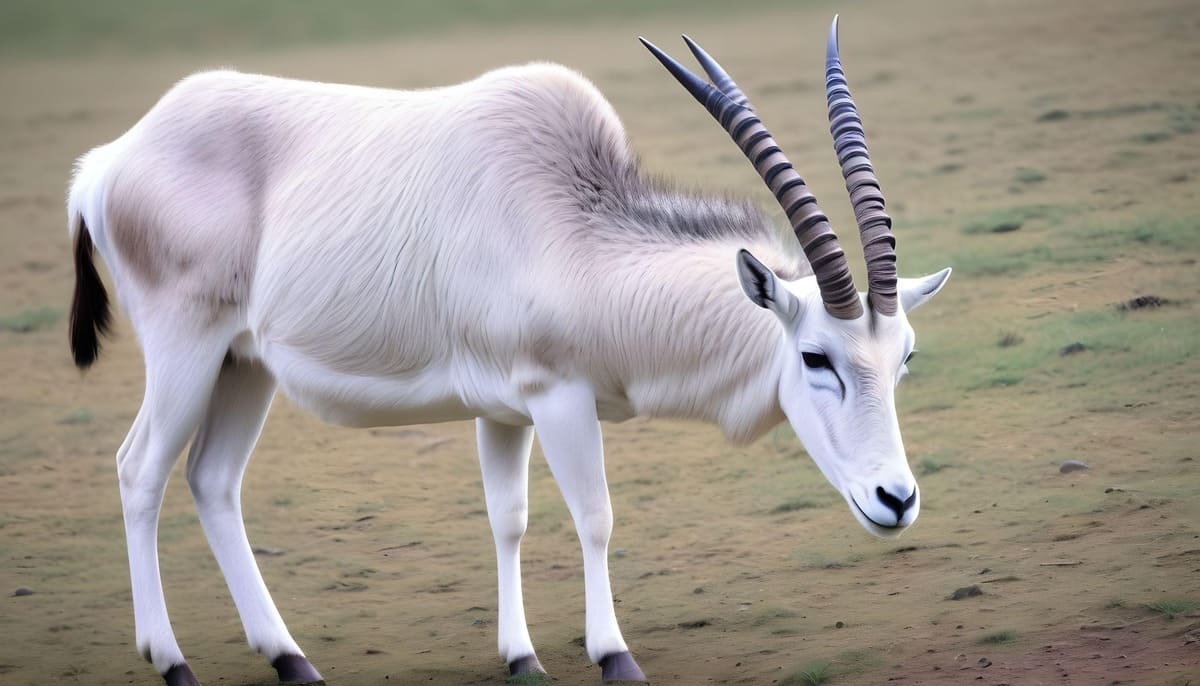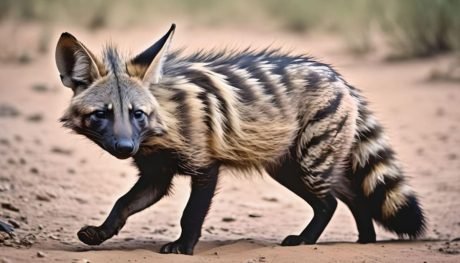Addax | Breed Overview, History, 12 Facts, Diet, Conservation, Care
🌍✨ Delve into the captivating world of the Addax, a critically endangered antelope with a story as unique as its corkscrew-like horns. In this SEO-friendly exploration, we’ll uncover the distinctive features that define the Addax, from its pale desert-adapted coat to its adaptations for thriving in arid landscapes. Join us on a journey through the challenges it faces, the conservation strategies employed, and the collaborative efforts essential for securing the future of this remarkable species. 🦌🌿 #Addax #WildlifeConservation #EndangeredSpecies #NatureExploration
Addax
The addax, recognized for its distinctive spiral-horned elegance, stands as a remarkable species within the antelope family. Native to the arid expanses of the Sahara Desert and other dry regions in Africa, the addax showcases a unique set of features that enable it to thrive in harsh environments. One of its most striking characteristics is the corkscrew-like horns that adorn its head, adding to the species’ allure.
The physical adaptations of the addax extend beyond its impressive horns. Its coat, varying from creamy white to sandy hues, serves as effective camouflage against the desert backdrop. The hooves of the addax are specially designed for navigating the sandy dunes, reflecting the species’ evolution to cope with the challenges of its habitat.
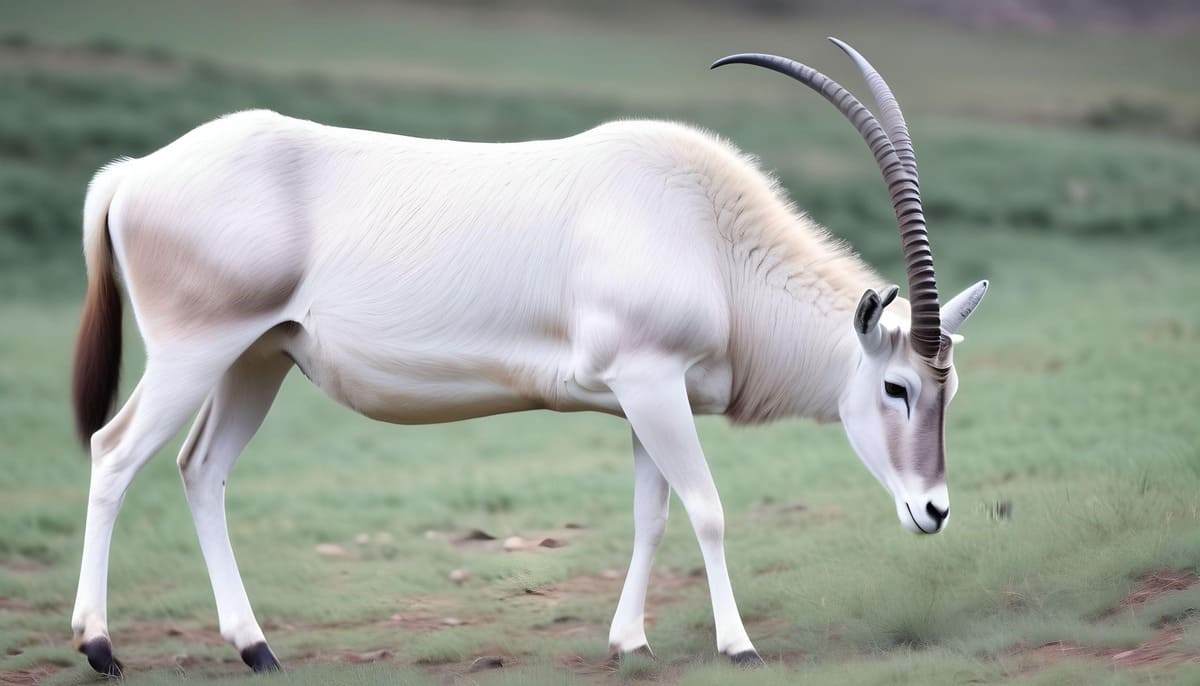
In terms of behavior, addaxes often form small herds, fostering a sense of cooperation to tackle the difficulties presented by their arid surroundings. These herds demonstrate intricate communication patterns and coordinated movements, underlining the social intelligence of these animals. The ability to work together enhances their chances of survival in an environment where resources are scarce.
Despite their adaptive prowess, addaxes face significant threats, pushing them to the brink of extinction. Habitat loss due to human activities and poaching for their distinctive horns have led to a critical endangerment status for the species. Conservation initiatives are crucial to protecting the remaining populations and ensuring the survival of this unique antelope.
Characteristics and Overview of Addax
Here are some common Characteristics and Overview of Addax:
| Characteristic | Description |
|---|---|
| Habitat | The addax is native to the Sahara Desert and other arid regions in Africa. |
| Physical Features | It possesses distinctive, corkscrew-like horns that contribute to its unique appearance. The coat ranges from creamy white to sandy colors, providing effective camouflage. |
| Adaptations | Specialized hooves aid in traversing sandy dunes. Physiological adaptations enable survival in extreme temperatures and scarce water conditions. |
| Social Structure | Addaxes often form small herds, relying on cooperation for navigation in challenging environments. |
| Behavior | Exhibits intricate communication methods and coordinated movements within herds, showcasing social intelligence. |
| Conservation Status | Classified as critically endangered due to habitat loss and poaching. Conservation efforts are underway to protect remaining populations. |
| Threats | Habitat loss, primarily driven by human activities, and poaching for their unique horns pose significant threats to the species. |
| Importance of Conservation | Conservation initiatives are crucial to preserving the addax’s biodiversity and ensuring the survival of this endangered species. |
Addax Geographic Range
The Addax, or Addax nasomaculatus, is predominantly found in the vast, arid expanses of the Sahara Desert and other dry regions across northern Africa. Their geographic range extends from Mauritania and Mali to Chad and Sudan. This species has evolved to thrive in challenging desert environments, showcasing remarkable adaptations to survive in regions with extreme temperatures and scarce water resources.

Origin, Evolution and History of Addax
The origin and evolution of the Addax trace back through the annals of time. This remarkable antelope species has adapted over millennia to the harsh conditions of its native habitat. While historical records provide insights into the interactions between humans and addaxes, their evolutionary journey is a testament to nature’s ability to shape resilient and uniquely adapted species.
Anatomy of Addaxs
The anatomy of the Addax is a marvel of evolutionary design, finely tuned for survival in arid landscapes. These antelopes boast distinctive, corkscrew-like horns that adorn their heads, contributing to their striking appearance. Their physical features, including specialized hooves and a coat ranging from creamy white to sandy colors, reflect adaptations that facilitate efficient movement across the sandy terrain of their habitat.
Appearance of Addaxs
The appearance of the Addax is characterized by its elegant and unique features. With a regal bearing, these antelopes showcase a robust body structure complemented by the notable corkscrew horns that can grow to impressive lengths. The creamy-white to sandy-colored coat provides them with effective camouflage in the desert environment, making them a captivating sight in their natural habitat.
Temperament of Addax
The temperament of the Addax is marked by a sense of resilience and adaptability. In the face of the challenging conditions posed by their arid habitat, these antelopes exhibit a calm and resourceful demeanor. Their ability to endure extreme temperatures and scarcity of resources highlights their adaptive nature, showcasing a temperament finely attuned to survival in harsh environments.
Behavior and Lifestyle of Addax
The behavior and lifestyle of the Addax are fascinating aspects of their existence. These antelopes often form small herds, relying on cooperation for survival in their challenging desert surroundings. The intricate communication methods and coordinated movements within these herds demonstrate the social intelligence of the species. Their lifestyle revolves around navigating the dunes and seeking sustenance in an environment where resources are limited.
Habitat and Distribution
The Addax’s habitat and distribution are primarily centered in the arid regions of Africa, with a focus on the Sahara Desert. Their adaptability allows them to navigate the challenging terrain, including sandy dunes and sparse vegetation. The distribution of Addax populations spans from Mauritania and Mali to Chad and Sudan, showcasing their ability to thrive in diverse desert landscapes.
Social Structure
The social structure of the Addax revolves around cooperative interactions within small herds. These herds, comprising individuals with diverse ages and sexes, exhibit a social dynamic that aids in navigating the challenges of their environment. The cooperative behavior and communication within these herds underscore the significance of social structures in the survival and well-being of the Addax population.
Addaxs Traits
The traits of the Addax encompass a range of characteristics that contribute to its survival in arid environments. Notable traits include adaptability, resilience, and the distinctive corkscrew horns. These traits have evolved over time, shaping the unique identity of this captivating antelope species.

Distribution and Habitat of Addax
The distribution and habitat of the Addax are centered in the arid landscapes of northern Africa, primarily the Sahara Desert. These antelopes have adapted to traverse sandy dunes and endure harsh temperatures, showcasing a remarkable ability to thrive in environments with limited water and vegetation.
Reproduction and Life Cycles of Addax
The reproduction and life cycles of the Addax are intricately linked to their environment. These antelopes typically engage in seasonal breeding, with females giving birth to a single calf after a gestation period. Understanding their reproductive patterns is crucial for conservation efforts aimed at sustaining and expanding Addax populations.
Communication, Vocalizations and Perception of Addax
Communication among Addax individuals involves intricate methods, including vocalizations and body language. These mechanisms play a vital role in coordinating movements within herds and establishing social bonds. Studying the communication and perception of Addax provides insights into their social dynamics and survival strategies.

Predators and Threats of Addax
Addaxes face various threats in their natural habitat, including predation and human-induced factors such as habitat loss and poaching. Understanding the predators and threats faced by Addax is essential for effective conservation strategies aimed at mitigating these risks.
Addax Ecological Niche
The ecological niche of the Addax highlights its role in the ecosystem. As herbivores, Addax contribute to shaping vegetation patterns and are integral to the food web. Exploring their ecological niche provides a comprehensive view of their impact on local ecosystems.
Impact on Local Ecosystems
The impact of Addax on local ecosystems is significant. Through their feeding habits and interactions, these antelopes influence vegetation dynamics and contribute to the overall biodiversity of their habitat. Understanding their ecological impact is crucial for maintaining ecosystem balance.
Relationship with Other Species
The relationships between Addax and other species in their habitat form a complex web of interactions. Examining these relationships sheds light on the interconnectedness of biodiversity and highlights the importance of preserving multiple species within an ecosystem.
Addax Genome Sequencing and Conservation Genetics
Genome sequencing of the Addax offers valuable insights into its genetic makeup and potential adaptations. Conservation genetics utilizes this information to develop strategies for preserving genetic diversity and ensuring the long-term survival of the species.
Genome Sequencing Projects
Genome sequencing projects focused on the Addax contribute to scientific knowledge and conservation efforts. These projects aim to unravel the genetic code of the species, aiding in the development of targeted conservation strategies.
Conservation Genetics and Breeding Programs
Conservation genetics plays a pivotal role in managing Addax populations. Breeding programs, guided by genetic information, aim to maintain genetic diversity and address challenges such as inbreeding. These initiatives are critical for sustaining healthy and resilient populations.
Addax in Popular Culture and Mythology
The presence of Addax in popular culture and mythology reflects the cultural significance of these antelopes. Whether featured in stories, art, or symbolism, understanding their portrayal enriches our appreciation for the human-animal connection.

Cultural Significance
The cultural significance of Addax varies across regions and communities. From symbolic representations to traditional practices, exploring their cultural significance provides insights into the relationships between humans and this unique species.
Addax Tourism and Responsible Wildlife Watching
Addax tourism offers a unique opportunity for wildlife enthusiasts to observe these captivating creatures in their natural habitat. Responsible wildlife watching practices ensure minimal impact on the animals and their environment, fostering conservation-conscious tourism.
Balancing Tourism and Conservation
Balancing tourism with conservation efforts is crucial for sustainable ecotourism practices. Strategies that prioritize the well-being of Addax populations while allowing responsible tourism contribute to the long-term preservation of the species and its habitat.
Educational Initiatives for Tourists
Balancing tourism with conservation efforts is crucial for sustainable ecotourism practices. Strategies that prioritize the well-being of Addax populations while allowing responsible tourism contribute to the long-term preservation of the species and its habitat.
Facts about Addax
Here are some interesting facts about the Addax:
- Endangered Status:
The Addax (Addax nasomaculatus) is critically endangered, with a sharply declining population due to habitat loss, hunting, and other human-induced factors. - Distinctive Spiral Horns:
One of the most distinctive features of the Addax is its long, twisted, and corkscrew-like horns. These impressive horns can reach lengths of up to three feet and are present in both males and females. - Arid Habitat Adaptations:
Addaxes are well-adapted to arid environments, particularly the Sahara Desert. Their specialized hooves help them navigate the sandy desert terrain, and they have physiological adaptations to cope with extreme temperatures and limited water sources. - Camouflaged Coat:
The coat of an Addax varies in color, ranging from a creamy white to a sandy hue. This coloration provides effective camouflage against the desert landscape, helping them avoid predators. - Social Structure:
Addaxes often form small herds, displaying a cooperative social structure. This social behavior helps them navigate the challenges of their habitat and ensures better chances of survival. - Nocturnal Behavior:
To avoid the intense heat of the day, Addaxes are known to be primarily nocturnal, becoming more active during the cooler evening and early morning hours. - Reproduction Patterns:
Addaxes typically engage in seasonal breeding, and females usually give birth to a single calf after a gestation period. This reproductive strategy is influenced by the availability of resources in their arid habitat. - Threats and Conservation Efforts:
The primary threats to Addax populations include habitat destruction, hunting, and competition with domestic livestock. Conservation efforts involve protecting their remaining habitats, implementing anti-poaching measures, and captive breeding programs. - Conservation Genetics:
Genetic studies and genome sequencing play a crucial role in conservation efforts. Understanding the genetic diversity of Addax populations is essential for maintaining healthy and resilient individuals in both wild and captive settings. - Cultural Significance:
Addaxes hold cultural significance in various regions, featuring in local myths, folklore, and traditional practices. Understanding the cultural connections to this species adds an additional layer to their importance. - Zoo Conservation Programs:
Many zoos and wildlife conservation organizations participate in breeding programs to ensure the survival of the Addax species. These captive breeding initiatives aim to reintroduce individuals into protected natural habitats. - Global Distribution:
While historically widespread across North Africa, the current distribution of Addax is limited to isolated pockets in countries like Chad, Mauritania, Mali, and Sudan.

Pros and Cons of Addax
Here are some common pros and cons of the Addax (Addax nasomaculatus):
| Pros of Addax | Cons of Addax |
|---|---|
| Cultural Significance: Addaxes often hold cultural significance, representing connections between local communities and the natural world. | Endangered Status: Addaxes are critically endangered due to habitat loss, hunting, and other human-induced factors. Their populations face a serious risk of decline or extinction. |
| Biodiversity Contribution: In their natural habitat, Addaxes contribute to the biodiversity of ecosystems, playing a role in the food web and shaping vegetation patterns. | Habitat Destruction: Human activities, such as agriculture and infrastructure development, contribute to the destruction of the Addax’s natural habitat, leading to population fragmentation and decline. |
| Educational Opportunities: The presence of Addaxes in conservation programs and zoos offers educational opportunities for the public, fostering awareness about endangered species and the importance of conservation. | Human-Wildlife Conflict: In some regions, there may be conflicts between humans and Addaxes due to competition for resources or habitat encroachment. |
| Conservation Initiatives: Conservation programs and captive breeding efforts aim to protect and preserve the remaining populations of Addaxes, contributing to global conservation goals. | Genetic Diversity Challenges: Due to small and isolated populations, Addaxes face challenges related to genetic diversity, which can result in health issues and decreased adaptability. |
| Research Value: Studies on Addaxes, including genetic research and behavioral observations, provide valuable insights into conservation strategies and wildlife management. | Poaching Threat: Addaxes are targeted by poachers for their meat and distinctive horns, contributing to the decline of populations despite conservation efforts. |
| Tourism Revenue: Responsible wildlife tourism centered around Addaxes can generate revenue for local communities and conservation programs, supporting the protection of natural habitats. | Climate Change Vulnerability: Addaxes are vulnerable to the impacts of climate change, including changes in temperature, precipitation patterns, and habitat suitability. |
| Global Collaboration: Conservation efforts for Addaxes often involve collaboration between local communities, governments, NGOs, and international organizations, promoting a unified approach to conservation challenges. | Challenges in Captive Breeding: Captive breeding programs face challenges in maintaining genetic diversity and preparing individuals for potential reintroduction into the wild. |
Care Tips for Addaxs
Caring for Addaxes, especially in captivity or conservation programs, requires a thorough understanding of their natural habitat, behaviors, and nutritional needs. Here are some care tips for Addaxes:
- Habitat Design:
Create an environment that mimics the Addax’s natural habitat. This includes providing a spacious enclosure with sandy substrate for digging, rocks for climbing, and shelter for protection from the elements. - Temperature Control:
Addaxes are adapted to arid climates, so maintaining an appropriate temperature range is crucial. Ensure that the enclosure has both shaded areas to escape the heat and heated areas during cooler seasons. - Proper Nutrition:
Offer a well-balanced diet that replicates the Addax’s natural forage. This may include grasses, hay, and other vegetation. Consult with a wildlife nutritionist to create a diet plan that meets their nutritional requirements. - Access to Fresh Water:
Provide a constant and easily accessible supply of fresh water. Even though Addaxes are adapted to arid conditions, they still need regular access to water for hydration. - Veterinary Care:
Establish a relationship with a veterinarian experienced in exotic animal care. Regular health check-ups, vaccinations, and monitoring of the Addax’s well-being are essential for their long-term health. - Social Structure:
If kept in groups, monitor social interactions among Addaxes. Ensure that the social structure within the group is stable and that individuals are not exhibiting signs of stress or aggression. - Enrichment Activities:
Keep Addaxes mentally stimulated by providing enrichment activities. This can include novel objects, puzzle feeders, or opportunities for exploration within their enclosure. - Observation and Monitoring:
Regularly observe the behavior, eating habits, and overall condition of the Addaxes. Any changes in behavior or physical health should be promptly addressed. - Breeding Programs:
If involved in breeding programs, work closely with experts to ensure the health and genetic diversity of the population. Follow established guidelines for successful breeding and birthing. - Protection from Predators:
In both captive and conservation settings, implement measures to protect Addaxes from potential predators. This includes secure enclosures and surveillance systems. - Educational Initiatives:
If Addaxes are in a public facility, use the opportunity to educate visitors about the species, its conservation status, and the importance of preserving biodiversity. - Captive Breeding Programs:
For those involved in captive breeding programs, collaborate with other institutions to maintain genetic diversity and exchange individuals as part of a broader conservation effort.
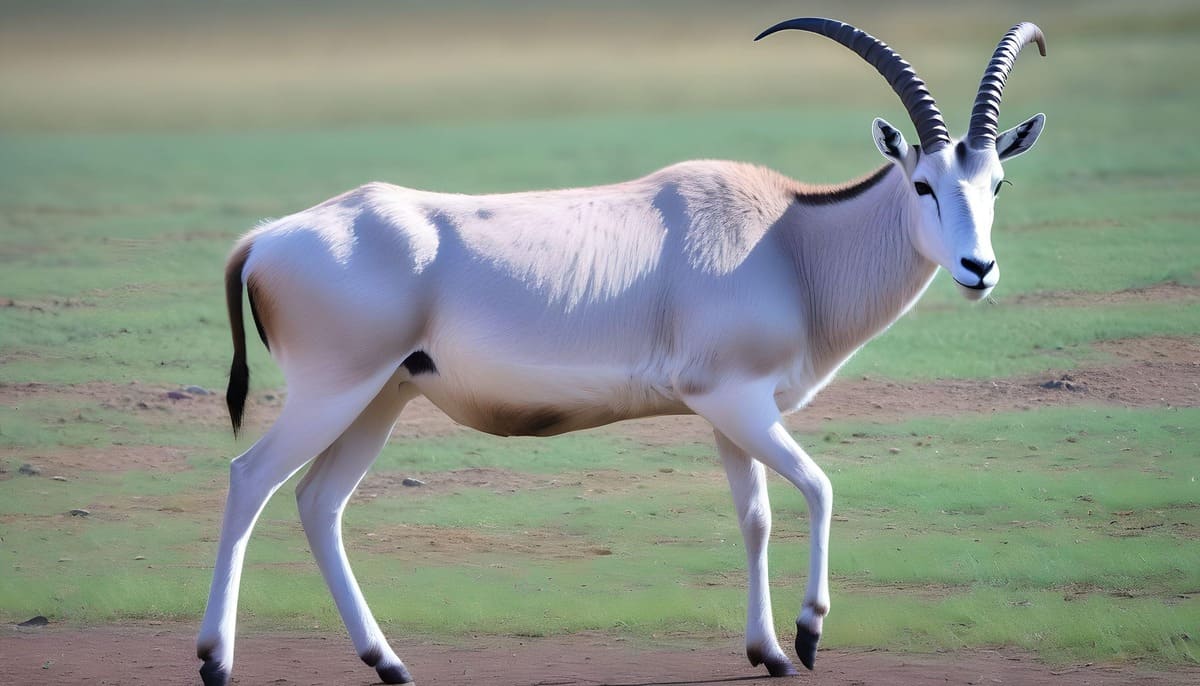
Addax Relationship with Humans
The relationship between Addaxes (Addax nasomaculatus) and humans has evolved over time, influenced by cultural, ecological, and conservation factors. Here are several aspects of the relationship between Addaxes and humans:
- Cultural Significance:
Addaxes hold cultural significance in various regions where they are found. They may be featured in local myths, folklore, and traditional practices. The cultural connection to these animals often reflects the historical and spiritual ties between local communities and the natural world. - Hunting and Conservation Challenges:
Historically, Addaxes have faced threats from hunting, both for their meat and their distinctive corkscrew-like horns. This has contributed to their critically endangered status. Conservation efforts aim to address these challenges by implementing anti-poaching measures and habitat protection. - Tourism and Wildlife Watching:
In some regions, Addaxes contribute to ecotourism initiatives. Responsible wildlife watching allows tourists to observe these captivating creatures in their natural habitat, fostering an appreciation for biodiversity. However, the balance between tourism and conservation must be carefully managed to avoid negative impacts on the species. - Conservation Programs:
Humans play a crucial role in the conservation of Addaxes. Conservation programs, both in situ (in their natural habitat) and ex situ (captivity), involve efforts to protect remaining populations, reintroduce individuals into suitable habitats, and engage in captive breeding to ensure genetic diversity. - Genetic Studies and Research:
Humans contribute to the understanding of Addaxes through genetic studies and research. Genome sequencing projects help scientists gain insights into the genetic diversity of populations, informing conservation strategies to maintain healthy and resilient individuals. - Education and Awareness:
Efforts to raise awareness about the critical status of Addaxes and the importance of their conservation involve educational initiatives. Public awareness campaigns, school programs, and outreach activities contribute to informed decision-making and support for conservation efforts. - Human-Wildlife Conflict:
In some cases, there may be conflicts between humans and Addaxes due to competition for resources or the impact of human activities on the antelope’s habitat. Balancing the needs of local communities with conservation goals is essential for sustainable coexistence. - Legal Protections:
Governments and international organizations recognize the need to protect endangered species like the Addax. Legal frameworks, such as wildlife protection laws and international agreements, aim to regulate human activities to ensure the conservation of these species. - Research and Monitoring:
Ongoing research and monitoring by scientists and conservationists help track Addax populations, understand their behavior, and assess the effectiveness of conservation strategies. This knowledge is crucial for adaptive management approaches. - Zoo and Captive Breeding:
Zoos and wildlife sanctuaries may play a role in the conservation of Addaxes through captive breeding programs. These institutions contribute to genetic diversity and may serve as a source of individuals for potential reintroduction efforts. - Collaborative Conservation Efforts:
Collaboration between local communities, governments, non-governmental organizations, and international agencies is essential for the success of conservation efforts. These partnerships help address the complex challenges faced by Addaxes and promote sustainable solutions.
Health Issues of Addax
The health of Addaxes, like any species, can be influenced by various factors, including their natural habitat, diet, environmental conditions, and interactions with other individuals. Here are some potential health issues that Addaxes may face:
- Disease Susceptibility:
Like many wildlife species, Addaxes can be susceptible to diseases. In captivity, close monitoring for signs of illness and routine health checks are crucial to prevent and address potential disease outbreaks. - Stress-Related Conditions:
Stress, often induced by changes in environment or social dynamics, can impact the health of Addaxes. Captive settings, in particular, need to be designed to minimize stress and provide enrichment activities to ensure mental well-being. - Genetic Diversity Concerns:
In small and isolated populations, such as those in captivity, genetic diversity can be a significant concern. Inbreeding may lead to health issues and decreased adaptability, emphasizing the importance of carefully managed breeding programs. - Reproductive Challenges:
Reproductive challenges, including difficulties during gestation and birthing, may arise. Ensuring proper veterinary care during the reproductive cycle and addressing any complications promptly is essential. - Dietary Issues:
Providing a nutritionally balanced diet is critical for the health of Addaxes. In captivity, zookeepers and wildlife caretakers must carefully manage their nutrition to prevent issues like malnutrition or obesity. - Habitat-Related Conditions:
In their natural habitat, issues such as habitat degradation, extreme weather events, and changes in vegetation patterns due to climate change can impact the health of wild Addax populations. - Parasitic Infections:
Parasitic infections, both internal and external, can affect the health of Addaxes. Regular parasite monitoring and appropriate veterinary interventions are essential for managing these issues. - Human-Induced Threats:
Human-induced threats, such as poaching or habitat destruction, not only affect population numbers but also contribute to stress and potential injuries. Conservation efforts are crucial to address these threats and protect the well-being of Addaxes. - Temperature Stress:
Addaxes are adapted to arid environments, and extreme temperatures can be a health concern. Ensuring proper shelter and temperature control in captive settings is essential to prevent heat stress or other related issues. - Behavioral Abnormalities:
Captive environments that do not adequately simulate natural behaviors can lead to stress and behavioral abnormalities. Providing opportunities for exploration, social interaction, and mental stimulation is essential for their well-being. - Veterinary Care Challenges:
Access to qualified veterinarians with expertise in exotic species is crucial for addressing health issues promptly. In some regions, providing adequate veterinary care for Addaxes can be challenging. - Conservation Challenges:
In the wild, the critical conservation status of Addaxes poses a significant health risk to the overall population. Addressing habitat loss, poaching, and other threats is essential for the long-term health and survival of the species.
Conservation Status of Addax
The Addax (Addax nasomaculatus) is classified as critically endangered by the International Union for Conservation of Nature (IUCN). This designation reflects the species’ highly precarious situation, with populations experiencing a severe decline primarily due to habitat loss, hunting, and other human-induced factors.

Current Population Status
As of the latest available data, the Addax population is alarmingly low. Estimates indicate that there are only a few hundred individuals remaining in the wild. These populations are fragmented and isolated, exacerbating the challenges faced by the species.
Threats and Challenges
The Addax faces a multitude of threats that contribute to its critical endangerment. The primary threats include:
- Habitat Loss: The expansion of human activities, such as agriculture and infrastructure development, leads to the destruction and fragmentation of the Addax’s natural habitat.
- Poaching: Addaxes are hunted for their meat and distinctive, corkscrew-like horns, which are sought after for ornamental and traditional purposes.
- Climate Change: Changes in climate patterns and increasing aridity in the Sahara Desert impact the availability of water and vegetation, further challenging the species.
- Human-Wildlife Conflict: Encroachment by humans into the remaining habitats of Addaxes contributes to conflicts, affecting both the antelopes and local communities.
Conservation Strategies and Technological Innovations
Conservation efforts for the Addax involve a combination of strategies and technological innovations, including:
- Protected Areas: Establishing and maintaining protected areas to conserve the remaining habitats of Addaxes and mitigate the impacts of human activities.
- Anti-Poaching Measures: Implementing anti-poaching initiatives to reduce illegal hunting and trade of Addaxes and their body parts.
- Captive Breeding Programs: Initiating and managing captive breeding programs to maintain genetic diversity and act as a potential source for reintroduction.
- Community Engagement: Involving local communities in conservation efforts to promote sustainable practices and reduce human-wildlife conflicts.
- Translocation: Consideration of translocation efforts to relocate individuals to areas with suitable habitats, promoting genetic diversity and population resilience.
- Research and Monitoring: Utilizing technological innovations for monitoring populations, studying behavior, and gaining insights into the health and dynamics of Addax populations.
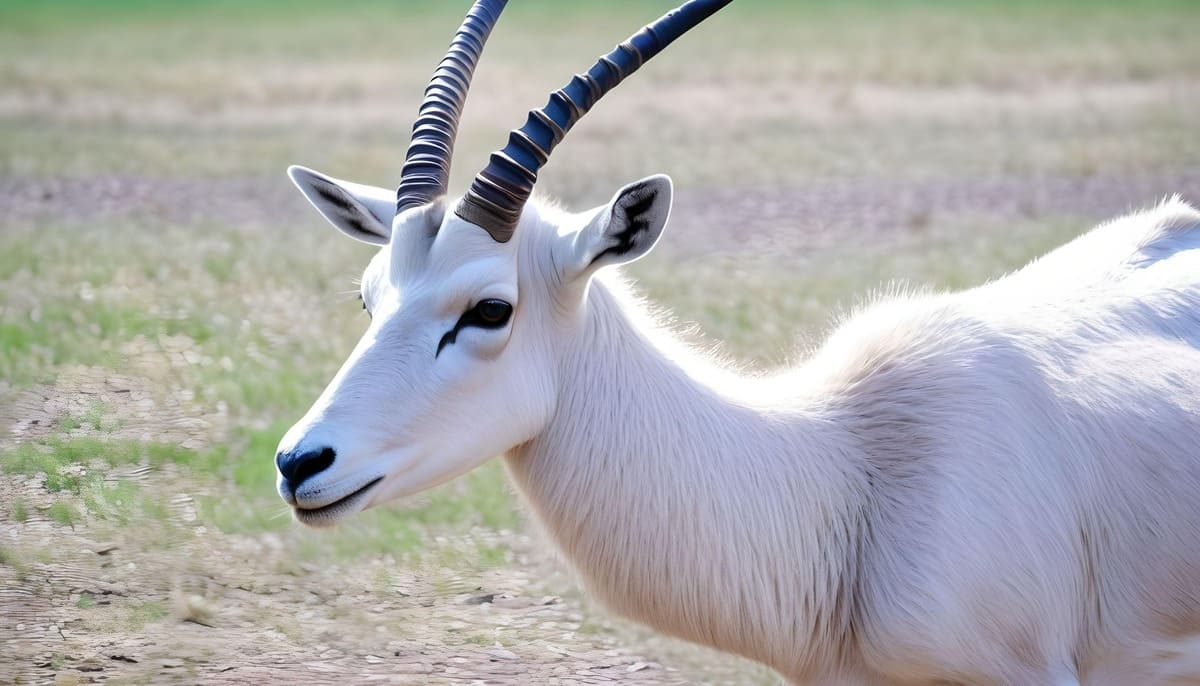
Technological Solutions for Monitoring Addax Populations
Technological Solutions for Monitoring Addax Populations:
- Satellite Tracking: Using satellite tracking devices to monitor the movements and habitats of Addaxes, providing valuable data for conservation planning.
- Camera Traps: Deploying camera traps in strategic locations to capture images and monitor population numbers, distribution, and behavior.
- Drones and Aerial Surveys: Conducting aerial surveys using drones to assess the size and health of Addax populations, particularly in vast and inaccessible areas.
- Genetic Studies: Employing advanced genetic techniques, including genome sequencing, to assess the genetic diversity and health of Addax populations.
- Remote Sensing: Utilizing remote sensing technologies to monitor changes in vegetation and habitat conditions, aiding in habitat management.
Community-Based Conservation Initiatives
Engaging local communities in Addax conservation is essential. Community-based initiatives may include:
- Education Programs: Raising awareness about the importance of Addax conservation, biodiversity, and sustainable practices.
- Livelihood Alternatives: Introducing alternative livelihoods that reduce dependence on activities detrimental to Addax conservation.
- Partnerships: Forming partnerships between conservation organizations and local communities to develop and implement conservation strategies collaboratively.
Addax Lifespan
In the wild, Addaxes typically have a lifespan of around 10 to 12 years. In captivity, with proper care and management, they may live longer, and some individuals have been known to reach 20 years or more. The captive lifespan can be influenced by factors such as diet, veterinary care, and the quality of their environment.
Physical Description of Addax
Here are some common Physical Description of Addax:
- Size and Build: Medium-sized antelope with males being larger (200-300 kg) than females (120-150 kg).
- Coat Color: Primarily pale, creamy white to sandy color, providing effective camouflage in the arid desert.
- Camouflage Adaptation: Light-colored coat acts as camouflage against the sandy desert landscape, aiding in predator avoidance.
- Horns: Distinctive corkscrew-like horns on both males and females, reaching lengths of 1 meter or more.
- Facial Markings: Black markings around the eyes and a dark stripe down the nose contribute to a unique facial appearance.
- Ears: Relatively small and rounded ears, contributing to a streamlined appearance.
- Tail: Short, tufted tail with a dark tip.
- Legs and Hooves: Slender legs adapted for traversing sandy terrain, with cloven and splayed hooves for stability.
- Adaptations to Arid Environments: Physiological adaptations to cope with arid conditions, including heat tolerance and water conservation.
- Life Span: Average lifespan of 10-12 years in the wild, while individuals in captivity may live longer, some reaching 20 years or more.

Diet and Prey of Addax
The Addax (Addax nasomaculatus) is herbivorous, and its diet primarily consists of vegetation adapted to arid environments. Here is a brief overview of the diet and prey (plants) of the Addax:
- Grasses: Addaxes graze on a variety of grasses, which are a significant component of their diet. They are adapted to consume the sparse vegetation found in arid regions.
- Forbs: Forbs, which are herbaceous flowering plants, also form part of the Addax’s diet. These plants provide additional nutrients and contribute to the antelope’s overall dietary diversity.
- Shrubs and Bushes: In their natural habitat, Addaxes browse on shrubs and bushes. These plants are often hardy and able to survive in arid conditions, providing a source of nutrition for the antelopes.
- Halophytic Plants: Addaxes are known to consume plants that are adapted to saline conditions, including certain halophytic species. These plants can tolerate high salt concentrations in the soil.
- Water Consumption: While the Addax is adapted to arid environments and can survive with limited water, they do require access to water sources. They obtain a significant portion of their water needs from the vegetation they consume.
- Adaptations to Arid Diet: The Addax has physiological adaptations that allow it to extract moisture from the plants it consumes, helping it survive in regions with limited water availability.
- Prey vs. Predator Terminology: It’s important to note that while the term “prey” is often associated with animals that are hunted, in the context of herbivores like the Addax, the term is used more broadly to describe the plants they consume. The Addax is not a predator; rather, it is a herbivorous prey species.
Addax Overview and Care Video
Conclusion:
In summary, the Addax, a critically endangered antelope, exhibits unique adaptations for survival in arid environments, including distinctive corkscrew horns and a pale coat for desert camouflage. Facing threats like habitat loss and poaching, conservation efforts involve community engagement, technological monitoring, and captive breeding. The Addax’s story underscores the delicate balance between its distinctive biology and the challenges posed by human-induced factors, emphasizing the urgent need for collaborative conservation initiatives to ensure its survival.
Frequently Asked Questions on Addaxs:
-
What is an Addax?
The Addax (Addax nasomaculatus) is a critically endangered antelope species known for its distinctive corkscrew-like horns and adaptations to arid environments.
-
Where are Addaxes Found in the Wild?
Historically widespread across North Africa, Addaxes are now limited to isolated pockets in countries such as Chad, Mauritania, Mali, and Sudan.
-
Why are Addaxes Critically Endangered?
Addaxes face critical endangerment due to habitat loss, hunting, poaching for their horns, and climate change, which collectively threaten their survival.
-
What is the Diet of Addaxes?
Addaxes are herbivores, primarily consuming grasses, forbs, shrubs, and plants adapted to arid conditions. They can extract moisture from their diet to survive in water-scarce environments.
-
How Long Do Addaxes Live?
In the wild, the average lifespan of an Addax is around 10 to 12 years, while individuals in captivity may live longer, with some reaching 20 years or more.
-
What is the Significance of Addaxes in Local Cultures?
Addaxes often hold cultural significance, featuring in local myths, folklore, and traditional practices in regions where they are found.
-
How are Conservation Efforts Addressing the Challenges Faced by Addaxes?
Conservation initiatives involve protecting remaining habitats, implementing anti-poaching measures, captive breeding programs, and community-based conservation efforts.
-
Can Addaxes Survive in Arid Environments?
Yes, Addaxes are well-adapted to arid environments. They have physiological adaptations to cope with extreme temperatures, limited water sources, and a diet suited to arid landscapes.
-
Are Addaxes Kept in Zoos?
Yes, many zoos participate in captive breeding programs to contribute to the conservation of Addaxes. These programs aim to maintain genetic diversity and support reintroduction efforts.
-
How Can I Contribute to Addax Conservation?
Individuals can contribute by supporting reputable conservation organizations, staying informed about the challenges faced by Addaxes, and promoting awareness about the importance of wildlife conservation.
-
What Technological Innovations are Used in Addax Conservation?
Technological solutions include satellite tracking, camera traps, drones, and genetic studies for monitoring populations, studying behavior, and gaining insights into the health of Addaxes.
-
Are There Educational Initiatives About Addaxes?
Yes, educational initiatives focus on raising awareness about the critical status of Addaxes, biodiversity conservation, and the importance of sustainable practices for both local communities and the global audience.
Recommended –

























